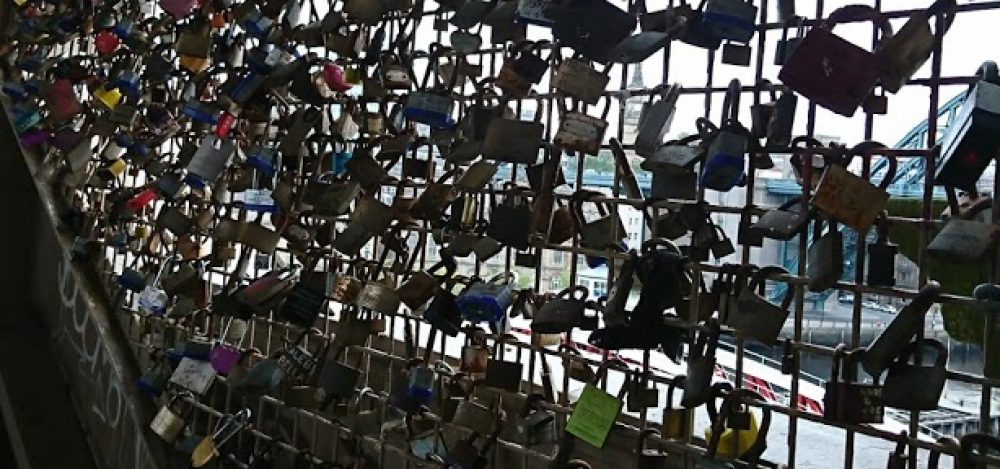For many – maybe most – of us, imagination is what gets us interested in history in the first place. Recently, the oral history collective have been having a lot of conversations about the connections between oral history and creative practice, including creative interpretation of history. In this post, Alison Atkinson-Phillips takes us on a winding journey of reflection on oral history and imagination, and offers a round-up of some local examples.
This blog post was sparked by a sound walk along the Tyne. Aeons was created by Martin Green for Opera North as part of the Great Exhibition of the North (it runs until 9 Sept 2018). Starting at the glass ‘box’ on the Quayside, near the Newcastle side of the Gateshead Millenium Bridge, you collect a set of headphones plus an audio player. As you walk along, different parts of the audio track are activated – Green describes it as being like an album where you have to physically walk along to trigger the next track. The audio includes the sound of the river itself, but another layer is a recorded narrative that is a kind of imaginary oral history of the river itself.
I won’t write a review of Aeons itself here (though I do recommend the walk and listen), but it made me think about the ethics of giving a voice to someone or something else – human or non-human. I worry about whether it’s possible to really ‘imagine’ what a river thinks or feels, but at the same time, I found that imaginary voice challenged me to consider the deep impact we have had on the river over time, and our relationship to it.
My experience of living and working in Australia already had me thinking about the line between imagination and history. Just before I left last year, I was at the ‘Feeling the Past: Indigenous Emotions and History‘ conference at the University of Western Australia’s (UWA) History of Emotions centre. Conversation there echoed comments I’d previously heard (for example from Aboriginal writer and academic Tony Birch) about the challenges of writing Aboriginal history in a context where Aboriginal archives have often been silenced or destroyed. In that context, we can ask what are the ethics of imagining how an 18th century Aboriginal woman might have felt but, as Shino Konisihi from UWA pointed out, we also need to think about the ethics of NOT doing so.
As Anna Clark says in the most recent History Lab podcast (also about a river):
“I guess there’s a real tension there between making shit up and doing history”
She also points out that what makes us historians is respect for the archive, in whichever form that takes. (Listen to the Fishing for Answers postcast here.)
Since my return to the North East earlier this year, I’ve been meeting a growing number of creative practitioners who draw on (and sometimes create) an oral history archive in their work.
Sometimes, the actual words or stories of oral histories are incorporated into a creative piece. Matt Stokes’s collaborative sound installation GOGMAGOG (at Holy Trinity, Sunderland, weekends until 23 Sept), for example, tells a social history of East Sunderland within an interpretation of the church’s historic bells. As Dave Pritchard says in his review:
If we doubt the ability of local communities to recognise their ‘ordinary’ heritage and articulate it imaginatively in present-day cultural contexts, this project should be a source of hope. It shows also what a crucial role can be played by contemporary artists, seeing how parallel stories layer through each other, and nudging everyone a little beyond their normal comfort zones to produce something of new value.
A different kind of creative practice is Akako Tani’s Vessels of Memory exhibition at the National Glass Centre (also in Sunderland), where the oral history informs creative works that themselves become another kind of archive. Tani conducted her own oral history interviews with local glassmakers who making glass ships in bottles during a boom in the industry in the 1970s and 1980s. She also followed a piece of glassmaking equipment from Sunderland to China and conducted interviews there. Interview extracts are included in the exhibition catalogue, and are also, via QR codes on the wall, part of the exhibition. These interviews are part of Tani’s research which, alongside her residency at the National Glass Centre with expert scientific glassblower Brian Jones and Norman Veitch, informed her practice, leading to her new body of work. Julie Stephenson states in the exhibition catalogue:
Ayako… has created a bridge between those who gained their skills in glassmaking through Sunderland’s industry and those who are taking glassmaking forward through visual art.
It is not just imagination, but also careful research and reflexive practice, that creates such bridges.
One other question this raises: is historical imagination the same for creative practitioners as it is for historians? And if not, what is the difference?
The Oral History Unit and Collective are planning an OH & Creative Practice ‘show and tell’ event in September to help us explore these and other questions in more detail. Email oralhistory@newcastle.org.au if you would like to know more, or sign up for our newsletter.
